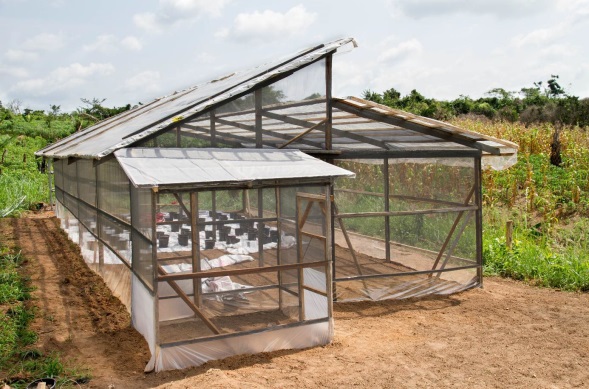Greenhouse Entrepreneurship – Business Development in Ghana
Greenhouse Entrepreneurship – Business Development in Ghana
Minor International Entrepreneurship & Development 2017
Location
Kumasi, Ghana
Students
Jorn Mieras
Nick van den Bovenkamp
Lim Chi Ho
During our three months stay in Kumasi Ghana, we are going to do a project in cooperation with the AfroEuro Foundation, following the planning you see below. During our internship, we want to make local young people enthusiastic about agriculture. Today, the average age of farmers is rising and because of that agriculture is less “sexy” for the young. The agriculture sector also lacks entrepreneurial minded people, despite that there is a lot of potential in this market. Due to that, the development of agriculture is going very slow. Our mission is to attract young local entrepreneurs, so the process of the development will be stimulated. To accomplish this goal, we want to start an education centre where young local farmers can learn the basics of agriculture and entrepreneurship. For this centre, we need a functioning greenhouse and teaching material. Fortunately, there is already a functioning greenhouse at the HortiTerra site. Our job will be the developing of the course material and workshops.

Our education program consists of three kinds of workshops. Firstly, building a greenhouse and keeping it in healthy and functioning condition. Secondly, growing vegetables in an efficient way in a greenhouse. Lastly, teaching the business side of running a greenhouse. For example, selling tomatoes, hiring people, book keeping and managing a small business. We already posses the two small manuals about building the greenhouse and growing the vegetables. These were made by the last group. We will revise these manuals and adapt them to be suitable for the education program. The manual about the business side of the greenhouse will be made during our stay in Ghana, by talking to the local stakeholders.
Depending on the amount of people who are interested in this program, more greenhouse space is needed. To realize extra space, we can build more greenhouses. The first student group from the Hortitera project has done research to bamboo greenhouses and they have made a construction plan to build one. This construction plan can be used to build extra greenhouses and generate more greenhouse space. Bamboo is far more sustainable than tropical wood, and is also cheaper. The downside is that bamboo needs a treatment to last at least 10 years and also the joint connections are more advanced, but we as technical students think that we can do more research on this. This research will be done in collaboration with KNUST, the university of Kumasi. We can make a manual for bamboo wood treatment and also add some basic bamboo joint connection strategies to it. A bamboo greenhouse will be more sustainable, more efficient and much cheaper than the already existing wooden greenhouse. When we reduce the costs of a greenhouse it will be more attractive for young people to build one their own and more profitable for our cooperation to lease it.


Evaluation
After 3 amazing months in Kumasi, Ghana, we finished our internship. Before we went to Kumasi, we agreed to work on three goals. We would help improving the first greenhouse and help finishing the second greenhouse. We would write education manuals for the trainings institute and we would write a communication plan. However, the reality was worse than what we expected. The condition of the first greenhouse got a lot worse for one year. So, in our first few weeks, we mainly focused on renovating the first greenhouse and helping finish the second greenhouse.
We encountered four main problems in the greenhouses. Originally the floor of the greenhouse existed of plastic bags. However, this plastic didn’t last for too long and there were even some plants growing inside the greenhouse. These plants can have diseases that can hurt the tomato plants. Replacing the plastics every year wasn’t a very sustainable solution, so we decided to put a concrete floor in the greenhouse, which can last for 10 years at least and is relatively cheap in Ghana. The second thing we did was to make sure the plants were protected against insects, since it is important that they are isolated from the outside world. However, there were some holes in the nets, and at other places the nets hung loose. We fixed all the holes and made sure the greenhouse was isolated again. The third problem we fixed were the plastics on the roof. The plastic that was used for the roof was in a very poor condition after only half a year of rain and radiation of sun. We replaced the old plastics with new UV protected plastics from the Netherlands and also installed the new plastics on the second greenhouse. The last big thing we adapted for the greenhouses was the capacity. In the previous growing season, HortiTerra grew 100 tomato plants in the greenhouse. We calculated and came to the conclusion that each greenhouse can grow at least 200 tomato plants simultaneously. By growing more tomato plants, you kill two birds with one stone. You will of course increase your yield but having more tomato plants will also result in cooling down the greenhouse, which is still a problem for greenhouses in Ghana.
After fixing the greenhouses, we focused on the education manuals. We got an amazing business manual from the KNUST and the building manual was already made by the last group of HortiTerra. We expanded and finished the tomato manual in a few weeks’ time, but we also did more research. During our stay in Kumasi, we realized that a lot of research needed to be done, before greenhouse farming could be profitable in Ghana. Currently, the greenhouses in Ghana aren’t making any profit, since they are too expensive and not enough knowledge about greenhouse farming is available in Ghana. We found some cheaper solutions, like different growing mediums, different soil placement and we looked at the option to install shade nets. We put all this research in our internship report and the future groups of HortiTerra can adapt the greenhouses based on this research. We also made a model for the education center for the future HortiTerra trainings institute.
As already said before, we believed a lot of research needed to be done before HortiTerra can become big in Ghana. We did research on greenhouse farming, but we also looked at the current business of HortiTerra. HortiTerra currently is making big losses, so we believed that something needed to change. We made a business model canvas of the current business model. We noticed that the business model didn’t focus enough on solving the two main problems with greenhouse farming in Ghana. Namely that there is not enough knowledge available and that current greenhouses are too expensive. Thus, we decided to come up with an alternative business model which does focus on solving these problems. Sadly, we didn’t have enough time or money to put this BMC into practice. However, we put the add-on BMC and the lean start-up plan in our internship report, so the future groups of HortiTerra can focus on this business plan and HortiTerra can finally start making some profit and become a very successful business.